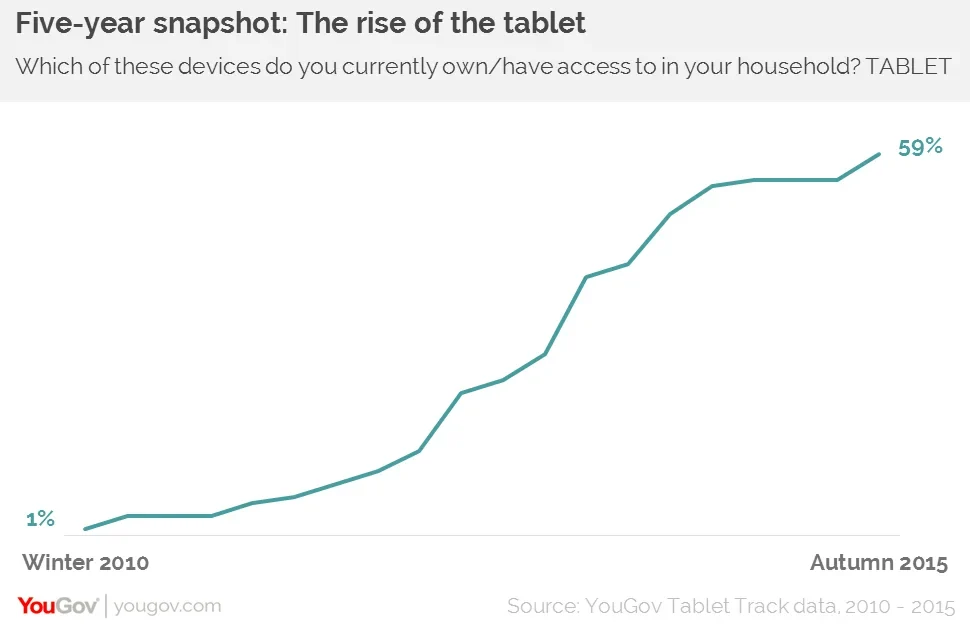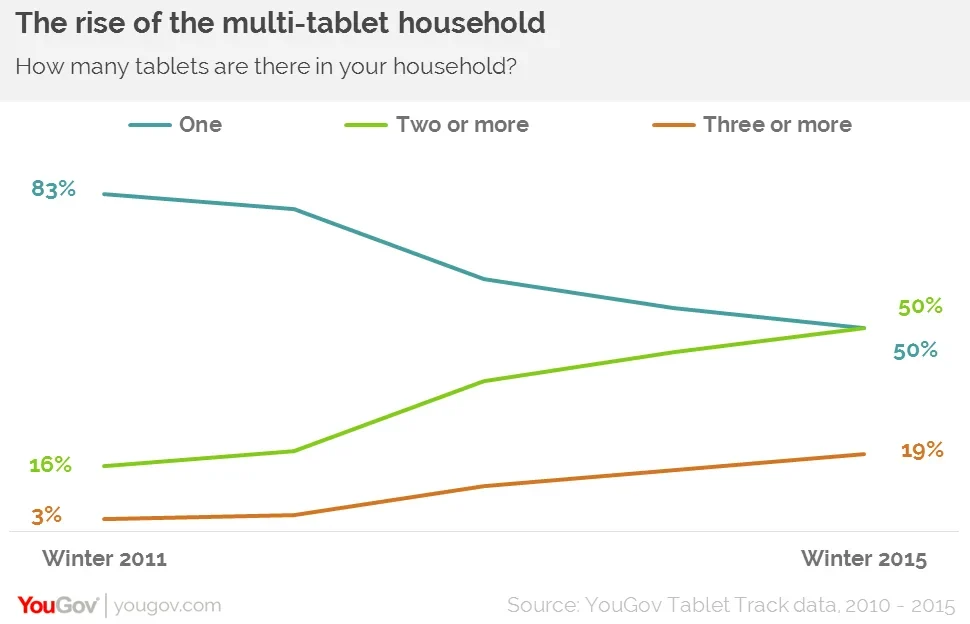For the first time more tablets are being bought by existing owners than new ones
Since tablet devices entered the market five years ago they have undergone astounding growth. From just 1% of households owning one in the winter of 2010, now almost six in ten (59%) do. However, over the past eighteen months there are signs that, by this measure the market is reaching saturation point, with its growth rate turning from a torrent to a trickle.

But why is this and what does it mean for manufacturers and retailers? The main reason is that the pool of purchasers has stopped getting any wider and has instead just got deeper. Our most recent figures show that half (50%) of tablet owners now own two or more of the devices, with 19% having three or more.

In short, when making new sales these days the industry is preaching to the converted – for the most part, those who want a tablet already own one. Those without one of the devices are currently unlikely to buy one. Indeed, we found that 13% of existing tablet owners will get another compared to purchase intent of just 10% among non-owners.
This decline has come about quite quickly. In spring 2015 approaching one in five (18%) people without a tablet was thinking about getting one in the following twelve months. By winter 2015 – the Christmas season and the prime time of year to get one of the devices – this figure was almost cut in half to just 10%.

But it is not that people have generally been turned off getting new pieces of tech. Earlier this year we saw purchase intentions for 2-in-1 devices (4%) exceeded that of tablets (2%) for the first time. Although the numbers are small, they could be very significant to the future of the device market.
2-in-1s have increased their market penetration over the past year, with our most recent data showing them growing from 3% in November 2015 to 4% in May 2016. This is solid growth for six months and, although the market is still at the early adopter phase, there are signs that it is starting to go beyond this audience and into the mainstream. Increased advertising around 2-in-1s is helping to build momentum behind the devices.
Between November last year and May this year, 2-in-1 owners have started to shift in age. Towards the end of 2015 approaching half (48%) were over-45s, but in May this year this had fallen to four in ten (42%). The main group taking up the devices in this period were those aged between 25 and 44.
As with any new device looking to crack into the market, early adopters tend to be people with means as new kit tends to be relatively costly. It is likely that the main reason for this increase in uptake of 2-in-1s among younger people is that newer, more affordable models and brands have entered the category. While not being the first in line for new kit, these people are still near the front of the queue.
Given the preponderance of laptops/desktops and tablets among the general population it is not a surprise that owners of 2-in-1s have ready access to these devices. However, there is a distinct cleavage here that is notable. While ownership of laptops/desktops is lower than the population at large (in May this year 83% owned these devices compared to 89% of all adults), tablet ownership among 2-in-1 owners is notably greater than the population at large (70% compared to 59%)

While it may seem a bit counter-intuitive, these figures suggests that tablets are a stopgap technology – filling a hole until a new device was released that combined both laptops and tablets.
This is because those who currently own 2-in-1s are, by their nature, early adopters. Not only are they among the first 4% of the population who own one of the devices, but they are the group who were most likely to get tablets and any new bits of tech kit. While they still own tablets now, this will not always be the case.
As the laptop/desktop ownership figures suggest, this group is also among the first to get rid of devices that they think are superfluous – presently it is desktops and laptops but in the future it will be tablets. As 2-in-1s edge towards the mass market it seems only a matter of time before the same thing happens among mainstream consumers.
While tablets were seeing a massive growth a few years back it may have seemed like an unlikely proposition, but the slow growth in the past eighteen months combined with the declining desire to buy new devices and the small-but-growing challenge from 2-in-1s, does make it seem entirely possible that the tablet explosion is coming to an end.
Obviously, it is unlikely that new releases by Apple and Samsung will struggle for sales. But significantly, the chances are that instead of these sales being made by newcomers they will be more likely be made by tablet veterans.
Such a situation would mean that manufacturers and retailers would have to re-think how they want to take new products to market. No longer would they have to promote the benefits of the technology, but instead they would have to demonstrate to a tech-savvy, educated, audience how each new iteration would add to or enhance their current experience.
There has been a small but notable growth in the 2-for-1 market and it is telling that 2-in-1 owners are less likely to own a desktop or laptop. These figures are interesting by themselves but when coupled with the general stagnation of the tablet market and the fact that the majority of tablets are now being sold to existing customers indicate a notable shift in the device market could be afoot.
It is likely that we are seeing the first indication of consumers seriously considering 2-in1s to be the device that straddles the divide between tablets and laptops.
As a result it looks as though tablets as we know them are starting to run out of road.
More information about YouGov's Digital, Media and Technology research
This piece originally appeared in IT Pro Portal
Image from PA







